Muskan Laul and Adyaan Ahmed, FischerJordan
AI algorithms offer potential solutions by assisting clinicians in screening high-risk individuals, triaging symptomatic patients, and improving cancer recurrence diagnosis. Leveraging diverse data sources such as electronic healthcare records, diagnostic images, pathology slides, and peripheral blood, these algorithms can provide valuable insights for accurate cancer detection.
However, challenges related to ethics, resource allocation, data security, and standardization need to be addressed for the widespread implementation of AI in clinical practice. With continued advancements in AI technology, there is a strong potential to enhance early cancer detection and improve patient outcomes worldwide.
Introduction
Cancer is the second leading cause of global mortality, taking over 600,000 lives in 2022, and poses a significant threat to second and third-world countries where cancer education, cancer screening processes, and cancer treatment services are extremely limited. Early cancer diagnosis and AI represents a field with tremendous potential. Screening programs have shown promise in improving early cancer detection and reducing mortality rates. Nevertheless, challenges persist in patient selection, risk stratification, and personalized approaches.
AI algorithms offer opportunities to analyze vast amounts of data from multiple sources, enabling the identification of subtle signals and enhancing screening processes. Furthermore, AI has the potential to facilitate cancer diagnosis by triggering investigations or referrals based on clinical parameters and automating clinical workflows, especially in settings with limited capacity.
This article focuses on the potential applications of AI in early cancer diagnosis. We explore various types of data suitable for computational analysis and discuss the clinical implications, including the current AI models employed in practice, while addressing limitations, ethical concerns, resource requirements, data security, and reporting standards.
Why is early detection important?
In India, as of 2020, over 50% of patients with the 5 most common sites of cancer (breast, lung, mouth, cervix, and tongue) are diagnosed in late stages, emphasizing the importance of early intervention to prevent cancer progression. However, achieving widespread early detection poses various challenges that need to be addressed.
The COVID-19 pandemic has had a significant impact on cancer screening services in India, leading to a decline in early detection efforts. While advanced treatments are available and accessible to a significant portion of the population, financial burdens pose a major barrier to receiving adequate care.
Limited health insurance coverage and insufficient reimbursement for cancer treatment expenses contribute to these financial challenges, including restrictive coverage, high deductibles, and long waiting periods. In addition, estimates suggest 100,000 cancer cases were likely to go undiagnosed each month during the pandemic.
Stigma and a lack of awareness about cancer in India are also significant issues. A pilot study revealed that a large proportion of the Indian population believes that cancer can be transmitted from person to person. Additionally, there is a shortage of oncologists, with approximately 50% of India’s oncologists in ten major cities, further widening the accessibility gap for cancer care and cancer education across the country.
Existing technologies
AI is a broad term that encompasses computer systems emulating human intelligence. Machine learning (ML) is a subset of AI that involves training algorithms to make predictions based on experience. ML can be categorized into supervised learning (using outcome data) and unsupervised learning (without outcome data).
Natural language processing (NLP) is another AI technique used to analyze unstructured clinical data and automate resource-intensive tasks. ML often involves separating data into training, validation, and test sets to optimize models. Deep learning (DL) is a subgroup of ML that constructs complex architectures resembling human brain neurons.
DL frameworks like Tensorflow and PyTorch facilitate model development and evaluation. Convolutional neural networks (CNNs) are a type of DL architecture that has revolutionized computer-vision research, particularly in areas like radiology and digital pathology.
CNN architectures enable the utilization of color images in computer-vision tasks. They utilize kernels that slide over image channels, extracting features such as edges and gradients. These features are then pooled, flattened, and passed through fully connected layers for further processing.
Different predefined CNN architectures, including AlexNet, EfficientNet, InceptionNet, ResNet, and DenseNet, offer varying complexities and find applications in various medical imaging fields.
The Internet of Medical Things (IoMT) has the potential to revolutionize healthcare by addressing numerous challenges and supporting government objectives. AI-driven diagnostics, personalized treatment, early identification of potential pandemics, and imaging diagnostics are among the potential benefits of IoMT.
India is actively developing AI-based approaches for cancer diagnosis, particularly for breast cancer detection using mammograms. Implementing AI systems during screening can help overcome delays caused by a shortage of expertise and improve overall efficiency in cancer diagnosis.
1. Imaging techniques
| Technique | Description |
| X-ray Computed Tomography (CT) |
|
| Magnetic Resonance Imaging (MRI): |
|
| Positron Emission Tomography (PET): |
|
CT, MRI, and PET are vital imaging modalities in cancer diagnosis and management. They aid in cancer screening, determining tumor size and shape, treatment planning, and monitoring therapy response. Advancements in CT scan speed, reconstruction algorithms, and PET/MR systems hold promise for improved accuracy and utility in cancer diagnosis and management.
2. Molecular Diagnostic techniques
| Technique | Description |
| Multi-parameter flow cytometry |
|
| Oncotype Dx |
|
| Synthetic biomarkers |
|
| Exosomes in bodily fluids |
|
| Nanotechnology |
|
| Fluorescence in situ hybridization (FISH) |
|
| Liquid biopsy |
|
| Volatile organic compound (VOC) analysis in breath |
|
| Long noncoding RNAs (lncRNAs) |
|
Future scope
The integration of artificial intelligence in healthcare brings a range of challenges, necessitating careful consideration and solutions. Ethical considerations, algorithmic fairness, data bias, governance, and security emerge as key concerns. To address these issues, ethical principles and frameworks are being developed, emphasizing the centrality of ethics and human rights in AI design and implementation. Model bias, particularly related to demographic characteristics, is a growing concern.
Data representation and bias can affect the accuracy and generalizability of AI models, highlighting the need for improved diversity in training data. Data curation, storage, and management are also important for maximizing the utility of datasets and ensuring good data stewardship. The requirement for large labeled datasets for training poses a challenge, but solutions such as transfer learning, self-supervised learning, and synthetic data generation are being explored.
Data security is a priority, and approaches like federated learning are emerging to enable secure model training without sharing sensitive data. One major criticism is the lack of rigorous evaluation for many AI models. The need for peer-reviewed publication, reproducibility, prospective studies, randomized controlled trials (RCTs), and external validation is essential to establish the reliability and generalizability of AI models in clinical settings. Efforts are being made to improve the standard of healthcare AI publications and provide clinicians with tools to critically appraise AI studies.
- Precision Medicine: AI is expected to play a significant role in advancing precision medicine approaches for cancer treatment. By analyzing genomic data, molecular profiles, and clinical records, AI can help identify personalized treatment strategies and predict treatment response, leading to more targeted and effective therapies.
- Liquid Biopsies: Liquid biopsies involve analyzing blood samples for the presence of circulating tumor cells, DNA, or other biomarkers. AI can aid in interpreting complex genomic data obtained from liquid biopsies, enabling early cancer detection, monitoring treatment response, and detecting minimal residual disease.
- Integrative Data Analysis: With the integration of multi-modal data sources such as genomics, proteomics, imaging, and clinical data, AI can provide a comprehensive view of cancer development and progression. This integration allows for more accurate prediction models and a deeper understanding of cancer biology.
- Real-time Monitoring: AI-driven wearable devices and sensors can continuously monitor physiological parameters, detect early warning signs, and alert individuals or healthcare providers about potential cancer-related abnormalities. This real-time monitoring could enable timely intervention and potentially save lives
Future Impact of AI on early cancer detection
Despite the early stages of implementation, the integration of AI in cancer detection shows promising potential, with a growing number of individuals being diagnosed with cancer through AI-enabled approaches.
Here are the incident and mortality rates of India from 2012-2035 for men and women. The values are projected for the next 15 years.
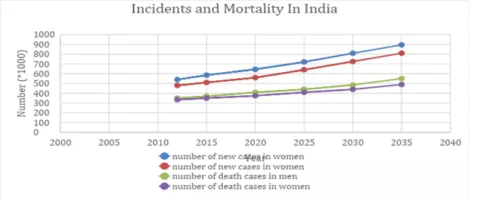
Figure 1: Projected Incidence and Mortality count in India
According to a report published by the National Cancer Institute (NCI) in 2022, an estimated 25% of cancer patients in India are diagnosed at an early stage. This means that only around 375,000 people in India were diagnosed with cancer at an early stage using AI in the last 5 years. Below are the charts for breast and lung cancer detections at different stages in India, USA, UK and China.
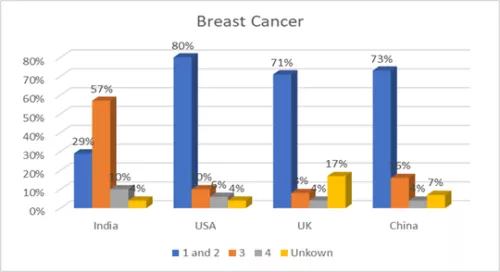
Figure 2: Breast Cancer detection at different stages, India vs other countries
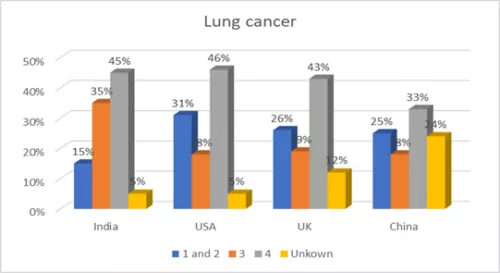
Figure 3: Lung Cancer detection at different stages, India vs other countries
Seeing the current numbers below are the projected numbers of how stage wise cancer detection looks like.
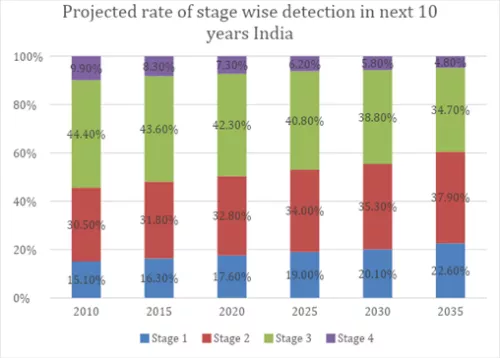
Figure 4: Projected rate of stage wise cancer detection in 10 years India
The actual number of people who are early detected using AI is expected to increase in the coming years as AI technology continues to develop and become more affordable and widespread.
Here are some of the AI applications to detect cancer at an early stage:
- PathAI: PathAI is an AI-powered tool that can help pathologists diagnose cancer more accurately. PathAI’s tool can analyze large amounts of tissue data and identify cancer cells with much greater accuracy than human pathologists.
- Enlitic: Enlitic is an AI-powered tool that can help to develop new cancer screening tests. Enclitic’s tool can analyze medical images and identify potential cancer lesions more accurately than traditional screening tests.
- Freenome: Freenome is an AI-powered tool that can help to develop personalized cancer treatment plans. Freenome’s tool can analyze a patient’s tumor DNA and identify genes that are driving the cancer which can be used to develop a personalized treatment plan that is tailored to the patient’s specific cancer.
The ongoing advancements in AI technology are poised to drive the development of additional AI-powered tools dedicated to early-stage cancer detection. This progressive integration of AI is expected to significantly enhance the rate of early cancer detection, ultimately leading to improved outcomes for individuals affected by cancer.
AI’s impact on cancer detection lies in the rate of improvement witnessed over time. In 2017, AI-powered tools exhibited an accuracy rate of 80% in detecting cancer at an early stage. By 2022, this accuracy rate had risen to 90%. Consequently, the rate at which AI is improving cancer detection in the early stages is approximately 10% per year.
It is important to note that this is just an estimate, and the actual rate of improvement may vary depending on the specific AI tool and the cancer type being detected. However, this data does suggest that AI is improving cancer detection at a significant rate.
The rate at which the use of AI technologies is spreading for early cancer detection is increasing rapidly. In the past few years, there have been several significant advances in AI-powered cancer detection tools, and these tools are becoming more widely adopted by hospitals and clinics.
According to a report by Grand View Research, the global market for AI in cancer detection is expected to grow at a compound annual growth rate (CAGR) of 32.4% from 2022 to 2028. This growth is being driven by several factors, including:
- The increasing accuracy and efficiency of AI-powered cancer detection tools
- The decreasing cost of AI technology
- The growing awareness of the benefits of early cancer detection
- The increasing investment in AI research and development
As these factors continue to drive growth in the AI cancer detection market, likely, the rate of adoption of these tools will also increase. In the next decade, we can expect to see AI-powered cancer detection tools become more widespread and integrated into standard cancer screening and treatment protocols.
Here are some predictions for the potential penetration of AI in cancer detection in the next decade:
- By 2030, AI-powered cancer detection tools could be used to screen for cancer in up to 50% of patients.
- AI could be used to develop personalized cancer treatment plans for up to 75% of patients.
- AI could be used to predict cancer recurrence in up to 90% of patients.
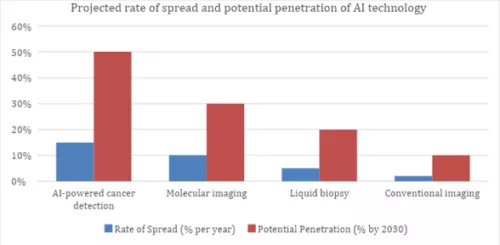
Figure 5: Projected rate of spread and potential penetration of the Ai technology in next 10 years in the world
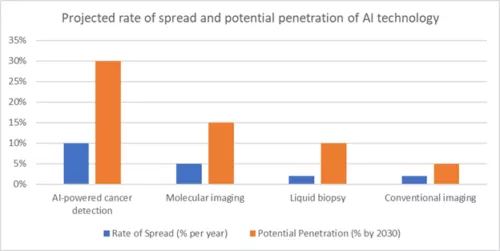
Figure 6: Projected rate of spread and potential penetration of the Ai technology in next 10 years in India
These predictions are based on the current rate of progress in AI cancer detection and the expected growth of the AI cancer detection market. However, it is important to note that these are just predictions, and AI’s use in cancer detection may vary depending on several factors, such as the availability of funding for AI research and development, the environment, and the acceptance of AI by patients and healthcare providers.
The rate of adoption and widespread implementation of various technologies for cancer detection in India is currently lower than the global average. This can be linked to factors including limited funding for research and development, the regulatory environment, and the acceptance of AI by patients and healthcare providers.
Nevertheless, AI-powered cancer detection is experiencing growth in India. This can be credited to the continuous enhancement of accuracy and efficiency in AI-powered cancer detection tools, the declining cost of AI technology, and the increasing awareness regarding the benefits of early cancer detection.
Projections indicate that the rate of improvement in early-stage cancer detection, facilitated by AI, is expected to rise steadily in the coming years. This will be driven by the ongoing development of new AI-powered tools and technologies, along with their increased accessibility.
Annual data further supports this trend, particularly in breast cancer, where the anticipated increase in the rate of improvement in early-stage detection due to AI is approximately 10%. Additionally, colorectal cancer is expected to experience a rise of approximately 5%, while lung cancer is projected to improve by about 3%. These findings highlight the potential and significance of AI in enhancing cancer detection rates at early stages in India, paving the way for improved patient outcomes and a more effective healthcare system.
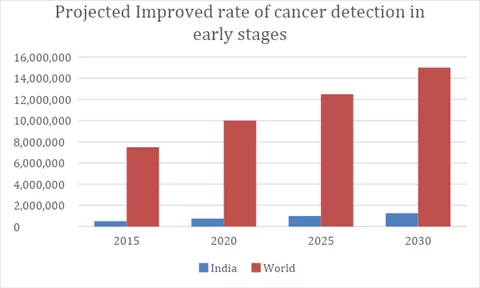
Figure 7: Projected Improved rate of cancer detection in early stages In india
Conclusion
The integration of AI in cancer detection shows promising potential, particularly in the early-stage detection of cancer. The use of AI-powered tools has already demonstrated notable advancements in accuracy and efficiency, outperforming traditional methods in identifying cancer cells and potential cancer lesions. While the current rate of early cancer detection using AI in India is estimated at around 25%, this is expected to increase in the coming years as AI technology continues to develop, become more affordable, and gain widespread adoption.
The projected growth of the AI cancer detection market supports this trend, with a compound annual growth rate of 32.4% expected globally from 2022 to 2028. Factors driving this growth include the increasing accuracy and efficiency of AI-powered tools, decreasing costs of AI technology, growing awareness of the benefits of early cancer detection, and significant investments in AI research and development.
Based on the current rate of progress and market growth, predictions suggest that AI-powered cancer detection tools could be used to screen up to 50% of patients, develop personalized treatment plans for up to 75% of patients, and predict cancer recurrence in up to 90% of patients by 2030. However, it is important to note that these predictions depend on various factors, such as funding, regulatory environments, and the acceptance of AI by patients and healthcare providers.
While the rate of adoption of AI technologies for cancer detection in India currently lags behind the global average, there is a clear upward trend. Factors such as the continuous enhancement of AI tools’ accuracy and efficiency, declining costs, and increasing awareness of early cancer detection benefits contribute to this growth. It is expected that the rate of improvement in early-stage cancer detection, facilitated by AI, will continue to rise steadily in the coming years, resulting in improved patient outcomes and a more effective healthcare system.
In summary, the integration of AI in cancer detection holds great potential in improving early-stage detection rates, enhancing patient outcomes, and transforming the healthcare landscape. With continued advancements and increased adoption of AI-powered tools, the future of cancer detection looks promising, bringing hope for a significant reduction in cancer-related morbidity and mortality.
References
- Ferlay J, Soerjomataram I, Ervik M, et al. GLOBOCAN 2012 v1.0, Cancer Incidence and Mortality Worldwide: IARC CancerBase No. 11.Lyon, France: International Agency for Research on Cancer, 2013. http://globocan.iarc.fr (accessed Dec 23, 2013).
- Engelgau MM, Karan A, Mahal A. The economic impact of non-communicable diseases on households in India. Global Health 2012; 8: 9.
- Ramsey S, Blough D, Kirchhoff A, et al. Washington State cancer patients found to be at greater risk for bankruptcy than people without a cancer diagnosis. Health Aff (Millwood) 2013; 32: 1143–52.
- Pramesh CS, Badwe RA, Borthakur B, et al. Delivery of affordable and equitable cancer care in India. Lancet Oncol 2014; published online April 11. http://dx.doi.org/10.1016/S1470-2045(14)70117-2
- Yancik R. Population aging and cancer: a cross-national concern. Cancer J 2005; 11: 437–41
- Bray F, Jemal A, Grey N, Ferlay J, Forman D. Global cancer transitions according to the Human Development Index (2008–2030): a population-based study. Lancet Oncol 2012; 13: 790–801.
- Forman D, Bray F, Brewster DH. In: Gombe Mbalawa C, Kohler B, Piñeros M, Steliarova-Foucher E, Swaminathan R, Ferlay J, eds. Cancer incidence in five continents, Vol X (electronic version) Lyon: International Agency for Research on Cancer. http://ci5.iarc.fr (accessed Dec 23, 2013).
- Kumar, Y.; Gupta, S.; Singla, R.; Hu, Y. A Systematic Review of Artificial Intelligence Techniques in Cancer Prediction and Diagnosis. Arch. Comput. Methods Eng. 2021, 29, 2043–2070.
- Iqbal, M.; Javed, Z.; Sadia, H.; Qureshi, I.; Irshad, A.; Ahmed, R.; Malik, K.; Raza, S.; Abbas, A.; Pezzani, R.; et al. Clinical applications of artificial intelligence and machine learning in cancer diagnosis: Looking into the future. Cancer Cell Int. 2021, 21, 1–11.
- Dias, R.; Torkamani, A. Artificial Intelligence in clinical and Genomic Diagnostics. Genome Med. 2019, 11, 1–12.
- Cancer. Who. Int. 2022. Available online:https://www.who.int/news-room/fact-sheets/detail/cancer(accessed on 13 October 2022).
Stay updated with all the insights.
Navigate news, 1 email day.
Subscribe to Qrius

